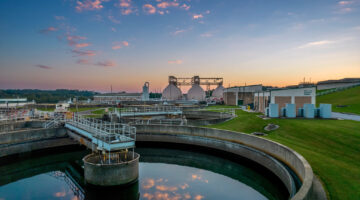From multi-billion-dollar data centers to expansive, fast-tracked water treatment facilities, these projects demand precision, innovation and strategic execution.
While very different on the surface, what do these two markets have in common? They carry high stakes, significant investment and ambitious timelines, all of which highlight the importance of expert planning and execution.
With the right strategies in place, these challenges become opportunities to drive efficiency, deliver on time and maximize long-term value.
Projects Don’t Go Wrong, They Start Wrong
Bent Flyvbjerg and Dan Gardner analyzed more than 16,000 large-scale projects across 136 countries and 20-plus sectors,* highlighting the common challenges jobs face, from complexity and long timelines to resource demands and market volatility.
What their research makes clear: Success in mission-critical construction doesn’t happen by accident. It’s shaped by decisions made well before a shovel ever hits the ground.
That’s where Kiewit stands apart. Our preconstruction approach digs deeper from the start. We take the time to fully understand project variables, build accurate budgets, and align the right people and strategies upfront. With the right foundation in place, we position our teams and clients for smarter execution, greater predictability and long-term success.
Preconstruction as a Strategic Discipline
At Kiewit, preconstruction is a mission-critical phase, not a formality or check-the-box exercise. From the earliest interactions with the client and key partners, our rigorous, iterative and deeply integrated preconstruction process helps identify and solve issues early — when it is most cost-effective and impactful to the project.
“Successful projects aren’t built on optimism and luck, they’re built on discipline,” says Robin Winslett, Preconstruction director at Kiewit. “We front-load the planning process with deep analysis, design iteration, constructability reviews and real-time estimating, so that by the time construction starts, we’re not guessing — we’re executing.”
Kiewit’s preconstruction teams are made up of market-focused design and construction operations professionals. They have deep expertise in the specialized demands of their specific sectors. These are experts who understand the complexities of their markets and how they translate into effective planning. From cost modeling and value engineering to procurement strategy and scheduling, every detail is carefully coordinated with one goal in mind: delivering greater project predictability.
We build on the traditional 30/60/90 design milestone approach by taking it to the next level through an integrated, continuous engagement model. Preconstruction at Kiewit isn’t limited to periodic check-ins, it’s an ongoing, hands-on process. Our teams are in constant collaboration, engaging in daily and weekly iterations to test assumptions, refine cost and schedule models, and identify risks early, well before they impact project outcomes. This proactive approach is what drives smarter planning and greater predictability from day one.
“At Kiewit, design is never handed off,” explains Robin Winslett. “We sit shoulder to shoulder with engineering, estimating and construction from the start — because execution success begins on day-one during planning.”
Built for Reality, Not Just Plans
Job projections should be grounded in hard evidence: labor productivity rates, supply chain volatility, permitting cycles and infrastructure dependencies.
This real-world awareness allows us to provide clients with clear, honest insights — even when the challenges at hand are complex.
“Our clients know we’re not going to sugarcoat the numbers just to win the job,” says Winslett. “Every change we make during preconstruction costs a fraction of what the same change would cost if made during execution – so it’s very important we are transparent and upfront with each other early on, even if it leads to some uncomfortable conversations.”
A Proven Path to Project Certainty
Kiewit has delivered some of the largest and most complex infrastructure projects in North America, and through that experience, we’ve seen a clear pattern: the most successful outcomes start long before construction begins.
Our preconstruction approach is shaped by years of lessons learned that have helped us uncover what works. It’s not just about technical expertise; it’s about disciplined, consistent planning. Execution doesn’t win the project, it proves the plan was right.
And the best plans? They’re the ones that start right. Consider these examples:
| Sherman Wastewater Treatment Plant A new wastewater treatment plant capable of treating up to 4 million gallons per day. |
|
| Preconstruction Efforts | Results |
|---|---|
| Kiewit worked with the City of Sherman from day one, developing a preconstruction plan tailored to the urgency of the City’s schedule which was greatly compressed. We structured early bid packages for long-lead equipment, site work and electrical, and released them before the project reached 60% design.
Further, we held discipline design meetings across every area of the project bringing in voices from the City, the Owner’s rep and plant operations staff. Everyone had a stake and a seat at the table. |
Kiewit has delivered over $17 million in value-engineering savings on this ongoing project, and is keeping the job on budget, without compromising quality.
|
| G3 Terminal A grain receiving, storage and shipping terminal. |
|
| Preconstruction Efforts | Results |
| Kiewit was brought in during front-end planning under an early contractor involvement (ECI) model, collaborating with the designers to develop the terminal layout, grain handling systems and construction approach concurrently. | This upfront engagement allowed the team to address construction challenges (such as building massive slip-formed concrete silos in a tight port site) in the design phase, avoiding late changes.
Kiewit implemented a phased-execution plan with stage-gate check-ins to regularly re-evaluate scope, budget and risks. By front-loading constructability reviews and scheduling analyses, the project achieved on-time completion. |
| Northwater Treatment Plant A new water treatment plant capable of treating up to 75 million gallons of water per day, and is expandable to 150 million gallons of water per day. |
|
| Preconstruction Efforts | Results |
| In addition to equipment pre-selection prior to the 60% design milestone, Kiewit’s in-house engineering and constructability teams collaborated with the designer to enhance plant layout, foundations and overall capacity to meet existing site and geotechnical constraints.
A constructability review of the distance between the headworks facility and the flocculation and sedimentation basins netted significant results. |
The equipment pre-selection required the design team to develop key equipment specifications early, usually prior to the 60% design milestone. This selection criteria was developed collaboratively with Kiewit’s influence. The criteria included items such as capital cost, performance capabilities and life-cycle cost.
Kiewit compiled the information necessary for an informed, best value selection to be made. This pre-selection process helped streamline the design, gave key operating points for connected design attributes and reduced effort during GMP development. The redesign eliminated the need for shoring, saving the client $1 million while allowing simultaneous construction that improved the schedule. |
| METRO Rail Expansion An expansion of the Houston light rail system to accommodate an annual amount of 11 million passengers. |
|
| Preconstruction Efforts | Results |
| Using design-build delivery, MEC (a Kiewit company) engaged in real-time design iteration during construction. The project team faced evolving requirements (changes in station designs, utility relocations, etc.), but by building flexibility into the plan early, they avoided timeline overruns.
To prevent late-stage surprises, MEC established its own off-site signal fabrication facility and wire shop to start building critical system components while civil designs were still being finalized. |
Despite design changes, early contractor involvement and creative sequencing (building multiple segments simultaneously) prevented scope creep from delaying the finish. These front-loaded efforts allowed the expansion to open on schedule, and this project is often cited as an innovative example of how preconstruction analysis and continuous design and construction feedback loops can lead to success in complex urban infrastructure builds. |
These are examples of what is possible when proper planning comes first. At Kiewit, challenges are addressed before they become problems, creating certainty for clients from day one.
“Kiewit served as an excellent partner to Denver Water and Jacobs during the three-year planning and design phases of the 75MGD CMAR Northwater Treatment Plant CMAR. Their expertise in estimating and the processes they brought to the team for value engineering and quantity tracking were instrumental in helping Denver Water achieve its budget and quality goals. This trust and rapport built with Kiewit’s staff throughout the preconstruction phase has proven invaluable during negotiations.”
— Peter McCormick, Denver Water
Preconstruction is not a phase; it is the foundation. And when you start with a foundation that is deep, data-driven and aligned with execution from day one, you do not just improve your chances, you redefine the outcome.
***
About the Author:
Robin Winslett is a Preconstruction Director for the municipal market at Kiewit, where he manages a team focused on delivering preconstruction services for water and wastewater projects. Robin has nearly three decades of experience across a variety of infrastructure markets including water and wastewater, power, oil & gas, industrial, and commercial building.
*Flyvbjerg, B., & Gardner, D. (2023). How big things get done: The surprising factors behind every successful project—from home renovations to space exploration. Currency.


